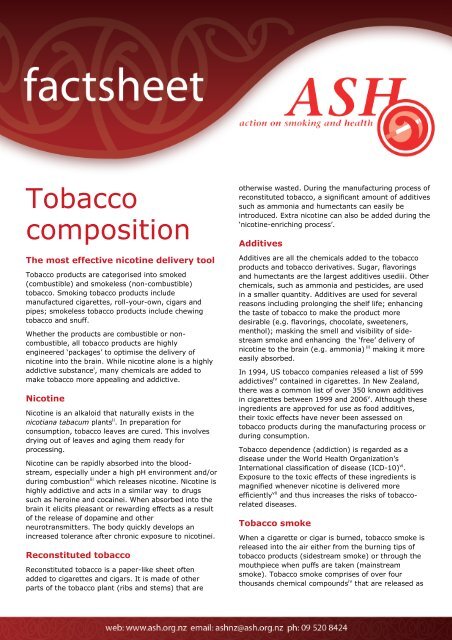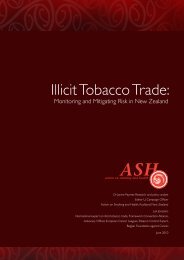ASH Tobacco Composition Fact Sheet
ASH Tobacco Composition Fact Sheet
ASH Tobacco Composition Fact Sheet
Create successful ePaper yourself
Turn your PDF publications into a flip-book with our unique Google optimized e-Paper software.
<strong>Tobacco</strong><br />
composition<br />
The most effective nicotine delivery tool<br />
<strong>Tobacco</strong> products are categorised into smoked<br />
(combustible) and smokeless (non-combustible)<br />
tobacco. Smoking tobacco products include<br />
manufactured cigarettes, roll-your-own, cigars and<br />
pipes; smokeless tobacco products include chewing<br />
tobacco and snuff.<br />
Whether the products are combustible or noncombustible,<br />
all tobacco products are highly<br />
engineered ‘packages’ to optimise the delivery of<br />
nicotine into the brain. While nicotine alone is a highly<br />
addictive substance i , many chemicals are added to<br />
make tobacco more appealing and addictive.<br />
Nicotine<br />
Nicotine is an alkaloid that naturally exists in the<br />
nicotiana tabacum plants ii . In preparation for<br />
consumption, tobacco leaves are cured. This involves<br />
drying out of leaves and aging them ready for<br />
processing.<br />
Nicotine can be rapidly absorbed into the bloodstream,<br />
especially under a high pH environment and/or<br />
during combustion iii which releases nicotine. Nicotine is<br />
highly addictive and acts in a similar way to drugs<br />
such as heroine and cocainei. When absorbed into the<br />
brain it elicits pleasant or rewarding effects as a result<br />
of the release of dopamine and other<br />
neurotransmitters. The body quickly develops an<br />
increased tolerance after chronic exposure to nicotinei.<br />
Reconstituted tobacco<br />
Reconstituted tobacco is a paper-like sheet often<br />
added to cigarettes and cigars. It is made of other<br />
parts of the tobacco plant (ribs and stems) that are<br />
otherwise wasted. During the manufacturing process of<br />
reconstituted tobacco, a significant amount of additives<br />
such as ammonia and humectants can easily be<br />
introduced. Extra nicotine can also be added during the<br />
‘nicotine-enriching process’.<br />
Additives<br />
Additives are all the chemicals added to the tobacco<br />
products and tobacco derivatives. Sugar, flavorings<br />
and humectants are the largest additives usediii. Other<br />
chemicals, such as ammonia and pesticides, are used<br />
in a smaller quantity. Additives are used for several<br />
reasons including prolonging the shelf life; enhancing<br />
the taste of tobacco to make the product more<br />
desirable (e.g. flavorings, chocolate, sweeteners,<br />
menthol); masking the smell and visibility of sidestream<br />
smoke and enhancing the ‘free’ delivery of<br />
nicotine to the brain (e.g. ammonia) iii making it more<br />
easily absorbed.<br />
In 1994, US tobacco companies released a list of 599<br />
addictives iv contained in cigarettes. In New Zealand,<br />
there was a common list of over 350 known additives<br />
in cigarettes between 1999 and 2006 v . Although these<br />
ingredients are approved for use as food additives,<br />
their toxic effects have never been assessed on<br />
tobacco products during the manufacturing process or<br />
during consumption.<br />
<strong>Tobacco</strong> dependence (addiction) is regarded as a<br />
disease under the World Health Organization’s<br />
International classification of disease (ICD-10) vi .<br />
Exposure to the toxic effects of these ingredients is<br />
magnified whenever nicotine is delivered more<br />
efficiently vii and thus increases the risks of tobaccorelated<br />
diseases.<br />
<strong>Tobacco</strong> smoke<br />
When a cigarette or cigar is burned, tobacco smoke is<br />
released into the air either from the burning tips of<br />
tobacco products (sidestream smoke) or through the<br />
mouthpiece when puffs are taken (mainstream<br />
smoke). <strong>Tobacco</strong> smoke comprises of over four<br />
thousands chemical compounds iv that are released as
airborne gases or particles; many are known to be<br />
carcinogenic, irritants or toxic.<br />
Gaseous compounds<br />
<strong>Tobacco</strong> smoke contains between 400 to 500 gases,<br />
including carbon monoxide, ammonia, formaldehyde,<br />
hydrogen cyanide and dimethyl-nitrosamine viii .<br />
Tar<br />
Tar is the sticky brown substance that stains smokers’<br />
teeth, fingers and lungs. Up to 70 percent of the tar in<br />
cigarettes remains inside the smokers lungs. Tar<br />
contains many known carcinogens including tobaccospecific<br />
N-nitrosamines, aromatic hydrocarbons; heavy<br />
metals such as lead, chromium and cadmium; as well<br />
as radioactive substance polonium-210 viii .<br />
‘Low’ tar cigarettes<br />
Nicotine and tar levels are assumed to be reduced by<br />
the cellulose acetate filter at the end of the cigarette,<br />
thus reducing the risks of many diseases. But the main<br />
function of the filter appears to be making the products<br />
more palatable to smokers and the actual health<br />
benefits are yet to be proven. Cigarettes with filters<br />
still kill half of their smokers.vii<br />
i<br />
Royal College of Physicians of London. 2000. Nicotine<br />
Addiction in Britain. A report of the <strong>Tobacco</strong> Advisory Group of<br />
the Royal College of Physicians.<br />
http://www.rcplondon.ac.uk/pubs/books/nicotine/ (Retrieved:<br />
12 th November 2008)<br />
ii<br />
Hoffmann, D. I. Hoffmann. 1998. Chemistry and Toxicology in<br />
Smoking and <strong>Tobacco</strong> Control Monograph No. 9.<br />
Bethesda,MD:US:National Cancer Institute. p. 55-104.<br />
iii<br />
Bates, C., Jarvis, M., Gregory, C., 1999. Cigarette engineering and<br />
nicotine addiction in <strong>Tobacco</strong> additives. <strong>ASH</strong> UK.<br />
iv Martin M. 2004. Smoking cessation: What’s in a cigarette? The List of<br />
Additives, A through C in About.com.<br />
http://quitsmoking.about.com/cs/nicotineinhaler/a/cigingredients.htm?p<br />
=1 (Retrieved: 5th November 2008)<br />
v Murray L. 2007. <strong>Tobacco</strong> returns for the 2006 calendar year. Report<br />
to the Ministry of Health. Health New Zealand Ltd.<br />
vi<br />
ICD-10: international statistical classification of diseases and related<br />
health problems: tenth edition. 2 nd edition. Geneva:World Health<br />
Organisation, 2004,<br />
vii World Health Organisation. 2006. <strong>Tobacco</strong>: deadly in any form or<br />
disguise. Geneva. Switzerland.<br />
viii<br />
Hoffmann D, Hoffmann I. 2001. The Changing Cigarette: Chemical<br />
Studies and Bioassays in Smoking and <strong>Tobacco</strong> Control Monographs<br />
13. Bethesda,MD:US:National Cancer Institute. p159-192.<br />
A common way in which ‘light and mild’ cigarettes are<br />
made is for manufacturers to put small vent holes into<br />
the filter tip. The level of perforation in the cigarette<br />
paper is deemed to reduce the levels of nicotine and<br />
tar. Low tar cigarettes are wrapped with more porous<br />
paper which dilutes the smoke and allegedly reduces<br />
nicotine and tar level. When the smoke is inhaled, a<br />
greater proportion of air combines with it to give the<br />
impression of smoothness. When these cigarettes are<br />
smoked by a machine the holes remain uncovered and<br />
it will therefore read lower yields of tar. When smoked<br />
by a person the fingers or the lips will cover the holes<br />
making the cigarette behave like a full strength<br />
product. Smokers will compensate the reduced amount<br />
of nicotine in each puff by smoking more or inhaling<br />
more deeply. A low tar cigarette is no safer than a high<br />
tar cigarette.vii





